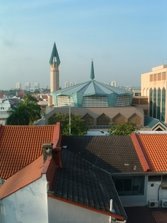1st Night- Friday
1. From Changi Airport (budget terminal ride the bus to main Changi Airport) to South East Asia Hotel:
Ride the MRT from Changi (interchange at Tanah Merah) to Bugis.
Bugis MRT is near the hotel, just follow the map on how to get there by foot.
2. After check-in, walk to Sim Lim Square and look for Ipods or any gadgets you like.
3. Walk to Singapore Art Museum at 71 Bras Basah. The entrance is free on Fridays from 6:00-9:00 pm and a guided tour at 7:00 pm.
4. Look around at Chijmes. Take lots of pictures.
5. Eat dinner at Bugis Village.
6. Walk back to South East Asia Hotel.
2nd Day- Saturday
1. From South East Asia Hotel to Singapore Zoo:
Ride the MRT from Bugis to Ang Mo Kio.
Transfer to SBS Bus # 138 and alight in front of the zoo located at 80 Mandai Lake.
2. Zoo Admission Ticket with Tram Ride (Adult)- SG$ 15.00
3. From Singapore Zoo to Grange Road:
Board SBS Bus 138 then alight at Ang Mo Kio MRT station.
Ride the MRT from Ang Mo Kio to Somerset. *** Jomar wanted to see the new Nano 4 GB Ipod release.
He said that there’s an Apple store in Grange Rd’s mall. We went there but was disappointed that there was no available Ipod.
4. From Grange Road to Sentosa:
Ride the MRT from Somerset (interchange at Dhoby Ghaut and Outram Park) to Harbour Front.
Board the orange Sentosa Bus at HarbourFront Bus interchange.
Board the Blue and Green Line Bus to go to
Sentosa Luge (Chairlift: return trip, 10 am - 7 pm),
The Merlion (last admission 7:30 pm)
and the Magical Sentosa Show @ Musical Fountain @ 7:40 pm, 8:40 pm. (Come one hour early).
5. Eat dinner at Lau Pa Sat:
From Sentosa to Lau Pa Sat:
Board the Sentosa Bus and alight at HarbourFront Interchange.
Ride the MRT from HarbourFront (interchange at Outram Park) to Raffles Place.
Walk towards Robinson Road, Boon Tat St. 18 Raffles Quay.
6. To go back to South East Asia Hotel, ride the MRT from Raffles Place to Bugis.
3rd day- Sunday
1. Attend Mass at 8:30 in the Church of St. Joseph.
2. Go to Sim Lim Square to buy a couple of gadgets.
3. Go to Chinatown Heritage Centre located at 48 Pagoda St. Sri Mariamman Temple, 244 South Bridge Road by taxi.
4. See Singapura Mall: From Chinatown, ride the MRT from Chinatown to Dhoby Ghaut.
5. Eat dinner at Glutton’s Bay: Walk to Orchard Road. Board SBS Bus #s 111, 162x, 502. Alight at Esplanade Theatre on the Bay opposite Marina Square. Watch the free free concert in Victoria Concert Hall at 8 pm.
6. Ride CityBuzz C3 “Little India Route” just to take a look around the 2nd level of the DoubleDecker Bus.
4th day- Monday
1. Kampong Glam: Walk along Victoria Street towards Arab Street and Sultan Gate Street towards the Malay Heritage Centre.
2. Route: Bussorah Street - Sultan Mosque - Muslim Good Shop - Old Istana Kampong Glam - Royal Graveyard.
*** If you’d like to enter the mosque, please wear sleeved blouses / shirts (ladies - long sleeves) and long skirts or pants.
4. From South East Asia Hotel to Budget Terminal, ride the MRT from Bugis (interchange at Tanah Merah) to Changi).
.jpg)
.JPG)

